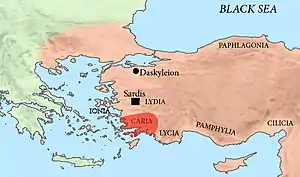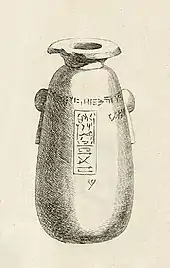
The Jar of Xerxes I is a jar in calcite or alabaster, an alabastron, with the quadrilingual signature of Achaemenid ruler Xerxes I (ruled 486–465 BC), which was discovered in the ruins of the Mausoleum at Halicarnassus, in Caria, modern Turkey, at the foot of the western staircase.[1] It is now in the British Museum, though not currently on display.[2]
Description
The jar contains the same short inscription in Old Persian, Egyptian, Babylonian, and Elamite:[1][3][4]
𐎧𐏁𐎹𐎠𐎼𐏁𐎠 𐏐 𐏋 𐏐 𐎺𐏀𐎼𐎣
(Xšayāršā : XŠ : vazraka)
"Xerxes : The Great King."— Old Persian inscription on the Jar of Xerxes, Mausoleum at Halicarnassus.[3]
The function of this jar is not well known. It may have contained some of the water from the Nile, received as a symbol of submission.[1] A few other examples of broadly similar jars are known throughout the Achaemenid Empire, including jar from Darius I.[1] The jar may have been part of the collection of the Carian Satrap, and testifies to the close contacts between Carian rulers and the Achaemenid Empire.[1][3]
The vases, of Egyptian origin, were very precious to the Achaemenids, and may therefore have been offered by Xerxes to Carian rulers, and then kept as a precious object.[4] In particular, the precious jar may have been offered by Xerxes to the Carian dynast Artemisia I, who had acted with merit as his only female Admiral during the Second Persian invasion of Greece, and particularly at the Battle of Salamis.[5]
The Jar is located in the British Museum.[6] Its height is 28.8 centimetres, its diameter 12.8 centimetres at the rim.[6] It was excavated by Charles Thomas Newton in 1857.[6]
 The Jar of Xerxes I, at time of discovery.
The Jar of Xerxes I, at time of discovery. Hieroglyphic inscription on the jar: "The great king Xerxes".
Hieroglyphic inscription on the jar: "The great king Xerxes". Cuneiform inscriptions on the jar ("The great king Xerxes" in three languages, Old Persian first).
Cuneiform inscriptions on the jar ("The great king Xerxes" in three languages, Old Persian first). The jar in the British Museum (side)
The jar in the British Museum (side)
Similar jars
A few similar alabaster jar exist, from the time of Darius I to Xerxes, and to some later Achaemenid rulers, especially Artaxerxes I.[1]
 Egyptian alabaster vase of Darius I with quadrilingual hieroglyphic and cuneiform inscriptions
Egyptian alabaster vase of Darius I with quadrilingual hieroglyphic and cuneiform inscriptions The Caylus vase, acquired circa 1760, was key in the decipherment of cuneiform.
The Caylus vase, acquired circa 1760, was key in the decipherment of cuneiform. Another jar of Xerxes I, at the Metropolitan Museum of Art.[7]
Another jar of Xerxes I, at the Metropolitan Museum of Art.[7] The same jar in black and white photography.[8]
The same jar in black and white photography.[8] Fragment of a jar of Xerxes I. Louvre Museum
Fragment of a jar of Xerxes I. Louvre Museum Jar of Xerxes I, year 2. Louvre Museum
Jar of Xerxes I, year 2. Louvre Museum
See also
References
- 1 2 3 4 5 6 Cambridge Ancient History. Cambridge University Press. 1924. p. 282-283. ISBN 9780521228046.
- ↑ Room 15, display case 3 (G15/dc3) "alabastron British Museum". The British Museum.
- 1 2 3 A Jar with the Name of King Xerxes - Livius.
- 1 2 Newton, Charles Thomas (1863). A History of Discoveries at Halicarnassus, Cnidus and Branchidae. Day & Son. p. 667.
- ↑ Mayor, Adrienne (2014). The Amazons: Lives and Legends of Warrior Women across the Ancient World. Princeton University Press. p. 315. ISBN 9781400865130.
- 1 2 3 British Museum Xerxes Alabastron.
- ↑ Metropolitan Museum of Art.
- ↑ Metropolitan Museum of Art.
- ↑ Revue archéologique (in French). Leleux. 1844. p. 444-450.
- ↑ The vase is now in the Reza-Abbasi Museum in Teheran (inv. 53). image inscription

.jpg.webp)